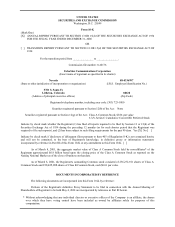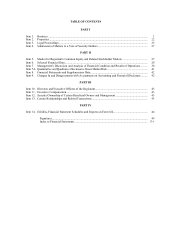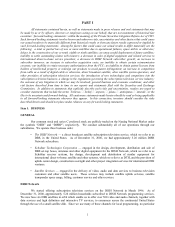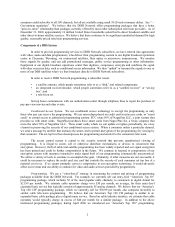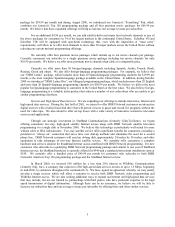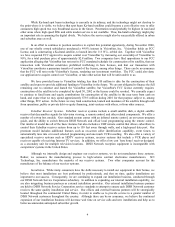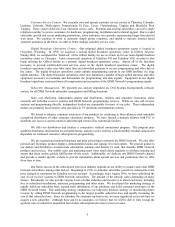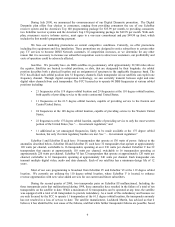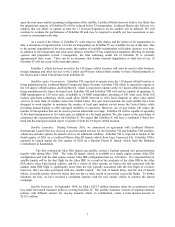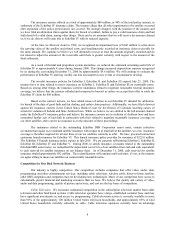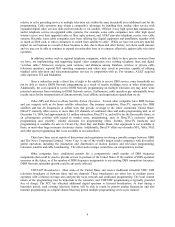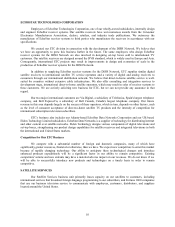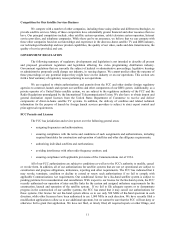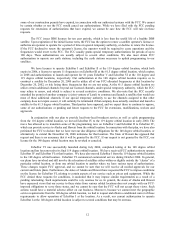Dish Network 2000 Annual Report Download - page 4
Download and view the complete annual report
Please find page 4 of the 2000 Dish Network annual report below. You can navigate through the pages in the report by either clicking on the pages listed below, or by using the keyword search tool below to find specific information within the annual report.2
consumer could subscribe to all 500 channels, but all are available using small 18-20 inch consumer dishes. See “—
Government regulation”. We believe that the DISH Network offers programming packages that have a better
“price-to-value” relationship than packages currently offered by most other subscription television providers. As of
December 31, 2000, approximately 16 million United States households subscribed to direct broadcast satellite and
other direct-to-home satellite services. We believe that there continues to be significant unsatisfied demand for high
quality, reasonably priced television programming services.
Components of a DBS System
In order to provide programming services to DISH Network subscribers, we have entered into agreements
with video, audio and data programmers, who deliver their programming content to our digital broadcast operations
center in Cheyenne, Wyoming, via commercial satellites, fiber optics or microwave transmissions. We monitor
those signals for quality, and can add promotional messages, public service programming or other information.
Equipment at our digital broadcast operations center then digitizes, compresses, encrypts and combines the signal
with other necessary data, such as conditional access information. We then “uplink” or transmit the signals to one or
more of our DBS satellites where we then broadcast directly to DISH Network subscribers.
In order to receive DISH Network programming, a subscriber needs:
•a satellite antenna, which people sometimes refer to as a “dish,” and related components;
•an integrated receiver/decoder, which people sometimes refer to as a “satellite receiver” or “set-top
box”; and
•a television set.
Set-top boxes communicate with our authorization center through telephone lines to report the purchase of
pay-per-view movies and other events.
Conditional Access System. We use conditional access technology to encrypt the programming so only
those who pay can receive the programming. We use microchips placed on credit card-sized access cards, or “smart
cards” to control access to authorized programming content. ECC owns 50% of NagraStar LLC, a joint venture that
provides us with smart cards. NagraStar purchases these smart cards from Nagra Plus SA, a Swiss company that
owns the other 50% of NagraStar LLC. These smart cards, which we can update or replace periodically, are a key
element in preserving the security of our conditional access system. When a consumer orders a particular channel,
we send a message by satellite that instructs the smart card to permit decryption of the programming for viewing by
that consumer. The set-top box then decompresses the programming and sends it to the consumer’s television.
The access control system is central to the security network that prevents unauthorized viewing of
programming. It is illegal to create, sell or otherwise distribute mechanisms or devices to circumvent that
encryption. However, theft of cable and satellite programming has been widely reported and our signal encryption
has been pirated and could be further compromised in the future. We continue to respond to compromises of our
encryption system with measures intended to make signal theft of our programming commercially uneconomical.
We utilize a variety of tools to continue to accomplish this goal. Ultimately, if other measures are not successful, it
could be necessary to replace the credit card size card that controls the security of each consumer set top box at a
material cost to us. If we cannot promptly correct a compromise in our encryption technology, it would adversely
affect our revenue and our ability to contract for video and audio services provided by programmers.
Programming. We use a “value-based” strategy in structuring the content and pricing of programming
packages available from the DISH Network. For example, we currently sell our entry-level “America’s Top 50”
programming package, which includes 50 of the most popular cable channels, to consumers in digital format for
$21.99 per month. We estimate cable operators charge over $30 per month, on average, for their entry-level
expanded basic service that typically consists of approximately 55 analog channels. We believe that our “America’s
Top 100 CD” programming package, which we currently sell for $30.99 per month, also compares favorably to
similar cable television programming. We believe that our America’s Top 100 CD package is similar to an
expanded basic cable package plus a digital music service. Based on cable industry statistics, we estimate that cable
operators would typically charge in excess of $40 per month for a similar package. In addition to the above
mentioned programming packages, during April 2000 we introduced our “America’s Top 150” programming

